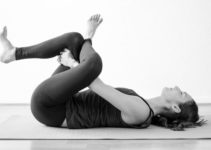
Tailbone, aka Coccyx, is a small bony structure at the very bottom of your spine or right above your buttocks. Pain in the tailbone, also called Coccydynia, can be felt when you sit down, lean back, or stand up from a sitting posture. Bad posture, wrong movements, and joint damage with aging are the main cause of your tailbone hurting.
Although yoga and other exercises are beneficial in relieving pain, inappropriate movement and posture while performing certain yoga poses can also cause Coccydynia. However in modern times, most often the cause of Coccydynia is the result of multiple unintended wrong sitting postures.
Yoga helps relieve your tailbone pain in two primary ways. Firstly, yoga spine stretches and elongation increases the mobility of your tailbone. And secondly, posture correcting yoga poses develop body awareness to ensure that you properly align your tailbone to avoid a wrong posture, even when you’re OFF the mat.
Pain-Relieving Tailbone Movements with Yoga
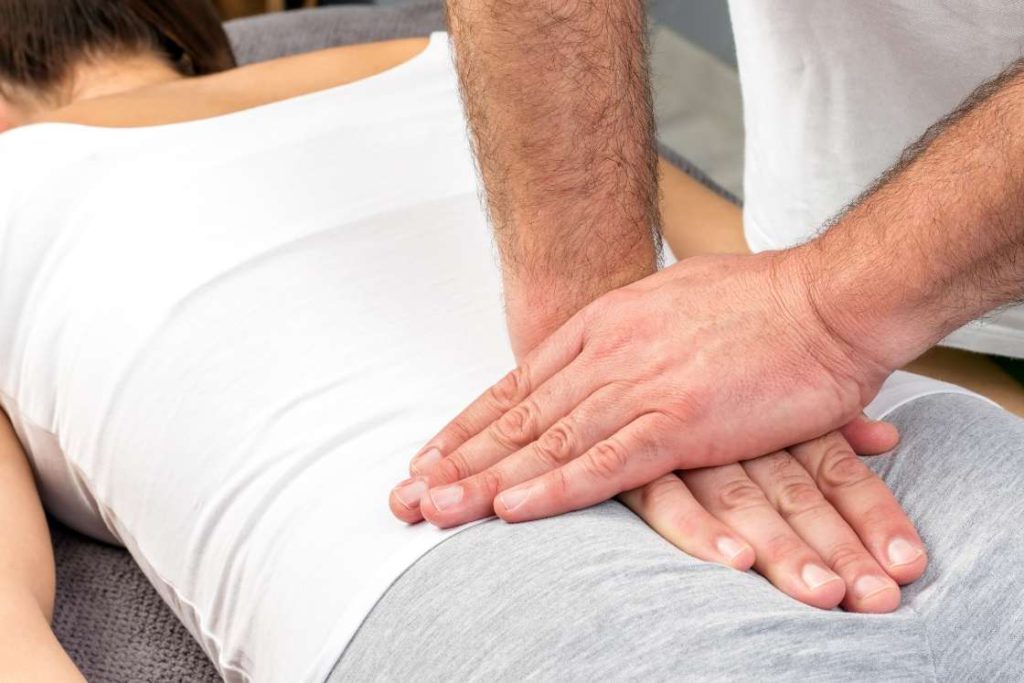
Yoga poses for tailbone pain involve subtle movements of your tailbone like, sacrococcygeal flexion, nutation/counter-nutation, and posterior tilting that will help you relieve your coccyx pain.
1. Sacrococcygeal Flexion
This movement will single out your tailbone from the rest of the spine and train it to flex forward. The cross-legged erect sitting of different yoga poses will achieve this movement. To execute this movement the yoga poses will engage the muscles in your pelvic floor.
The sacrococcygeal flexion will help you master the art of moving your tailbone without moving your spine or sitting bones. This movement is going to be solely the domain of yoga and not any other exercise, as it will have very little to do with muscle strength, and more with muscle awareness.
2. Nutation & Counternutation
These two movements are going to be engaged in standing yoga postures like Tadasana. The standing yoga positions for tailbone pain will keep your pelvis and the lumbar spine loose, and your sacrococcygeal flexion engaged. Only this time you are going to add a tilting backward and forward motion to the sacrococcygeal flexion, much like nodding. Your pelvic bones must have no movement.
From your sacrococcygeal flexion as you tilt away from your pelvis it is called nutation, and as you tilt back towards your pelvis, it is counter-notation. This nutation/counter-nutation will act much like non-static stretches that relieve joint pains. As you practice this movement you will find yourself building up a pleasantly strange rhythm between your breathing, spinal movement, and nervous sensations. Something that will result in a soothing effect for your pain.
3. Posterior Tilting
Posterior tilting is an extension of nutation movement. As you engage your tailbone into nutation, your pelvis will naturally want to get in on the movement. In nutation you resist, but in posterior tilting, you don’t. You put your pelvis into your nutation, and in fact, you further extend your nutation and hold it.
Adding posterior tilt in different yoga asanas like mountain pose, tree pose, chair pose, eagle pose increases the degree of relief from tailbone pain.
Yoga Poses for Tailbone Pain Relief
To relieve your tailbone pain you definitely need poses that stretch your spine. However, in yoga there are innumerous poses with spine involvement. You need to focus on poses that considerably involve the lumbar and tail end parts of your spine.
1. Mountain Pose – Tadasana
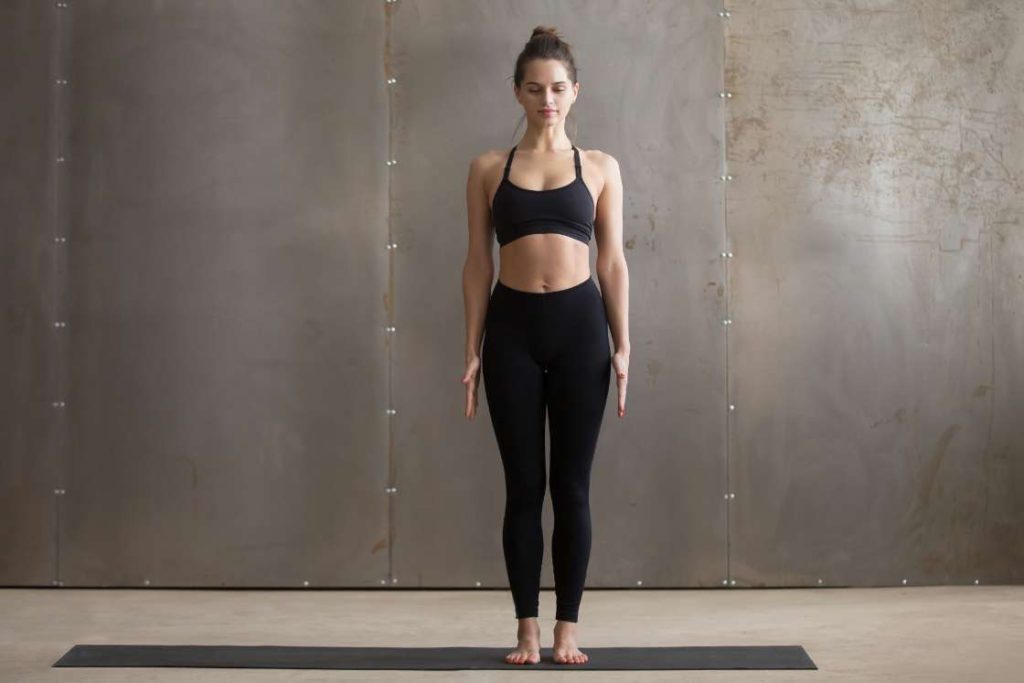
At first glance, this doesn’t look like a spine stretching pose, and it is not. As important as the stretches are, straightening exercises are equally important. Mountain pose exercise straightens your spine, back to the perfect erect posture. The Simplicity of this step will also allow you to focus separately on your tailbone, and give it some dedicated exercise.
- Stand erect with your legs hip-width apart.
- Keep your spine perfectly erect, in the posture, it is meant to be.
- Push back your head to keep it in line with your glutes, and increase your lumbar curve. This should create sacrococcygeal extension.
- Keep your shoulders pressed down, shoulder blades pressed against each other, chest out, and your hands straight by the sides of your body.
- Keep your palms open and facing front, with your fingers pointing down.
- Distribute your bodyweight evenly on both legs.
- Look front and breathe steadily.
- Hold the pose for a minute.
Note for tailbone – As you hold the tadasana position, feel the tailbone, down your spine. Concentrate to gain control of it and exercise it with extensions and forward and backward tilts.
2. Eye of the needle pose
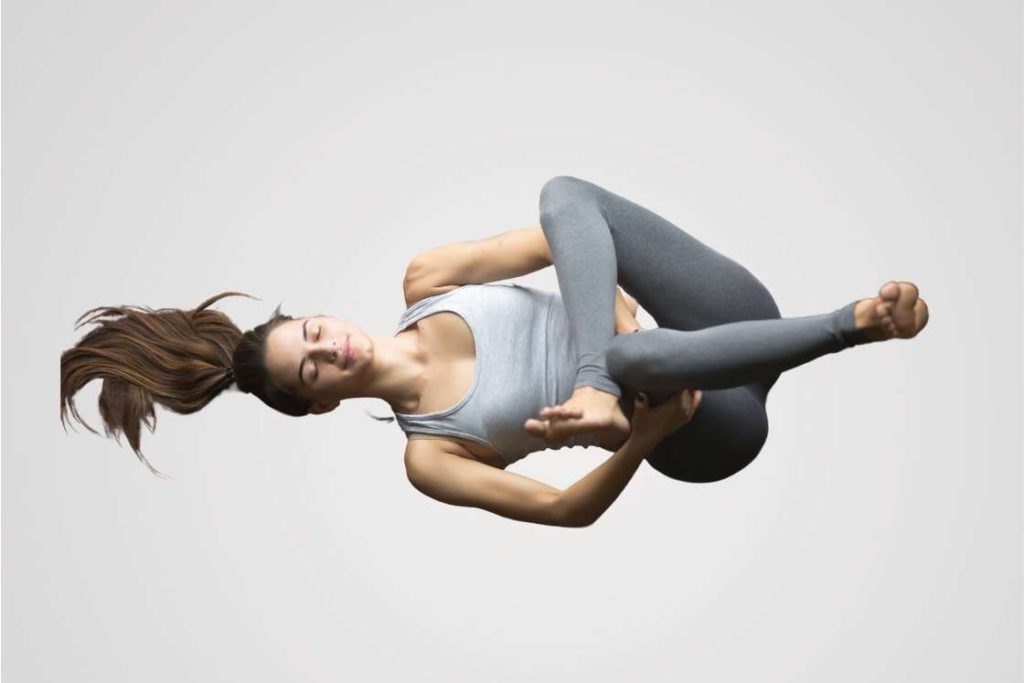
Eye of the needle is essentially a hip opening exercise. However, in the pursuit of hip opening, it works around with your tailbone as well. Eye of the needle is a pose that will naturally encourage your tailbone for nutation/counter-nutation movements.
- Lie supine on the floor
- Maintain the curve in your lumbar region, and do not touch your hip or lumbar region to the floor.
- Fold your knees, and lift them up, maintaining the gap between your lumbar and the ground.
- Lift your left leg, bring it over your right knee, placing your left ankle against your right knee.
- Now clasp your hands around your right thigh.
- Still maintaining your lumbar curve push on your hand with your thigh, away from your hip.
- As you have reached the farthest point, start pulling your thigh towards your hip.
- Pull to a point where your right knee is over your navel.
- Repeat the pose with other leg. And repeat the entire round 5-7 times.
Note for tailbone – As you push your thigh away from your hip, extend out your tailbone for posterior pelvic tilt, as pull your thigh in, tuck in your tailbone into counter-nutation.
3. Bridge Pose – Setu Bandhasana
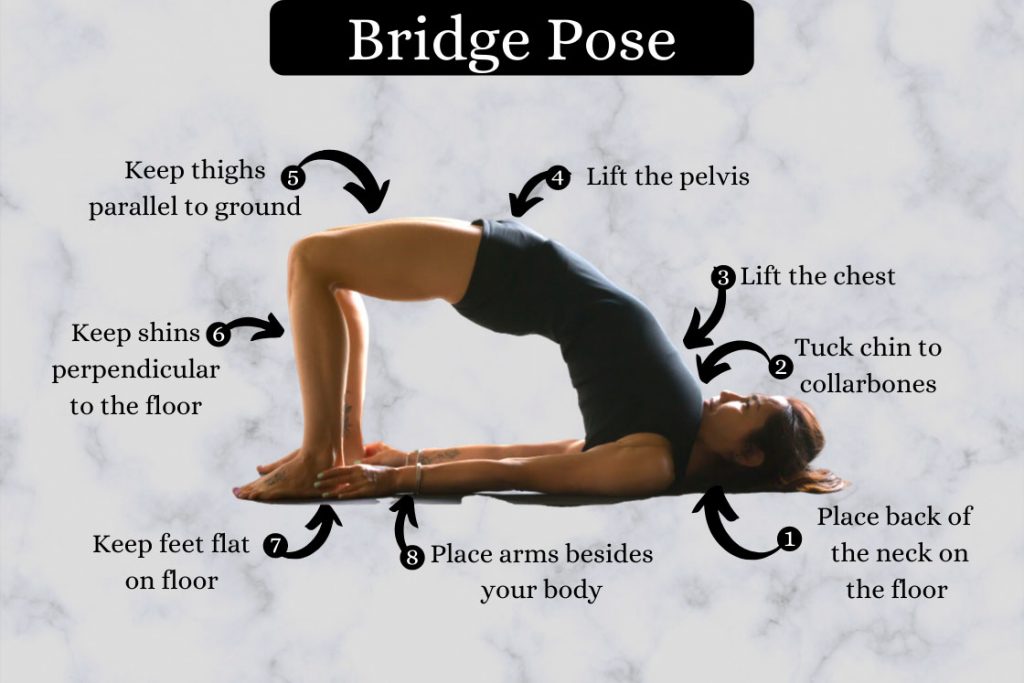
If tailbone relief is what you seek, you simply cannot do without the bridge pose. The bridge pose will not only relieve pain but also strengthen your tailbone to prevent future bruising. In the hold phase of the bridge pose, along with your hip and pelvic bones, your tailbone also learns to withstand a significant amount of workload.
- Lie supine on the floor.
- Keep your legs hip-width apart, and hands by the sides of your body.
- Bend and fold up your knees.
- Press down on the ground with your hands and feet.
- Use your quads, calf muscles, hamstrings, glutes, abs, chest and lower back muscles and lift up your pelvis.
- Keep lifting up till your pelvis is lifted up to your knee height, tailbone is pressed deep into your pelvic bones and chest is coming onto your chin.
- Don’t let your thighs extend outward.
- Keep your muscles engage and gold the pose for 5-7 breaths.
- Keep your hands pressed down on the ground, but bring them slightly closer to each other
Note for tailbone – This pose will naturally draw your tailbone into counter-nutation, without even you consciously trying for it. You can however, regulate the degree of counter-nutation.
4. Child’s Pose – Balasana
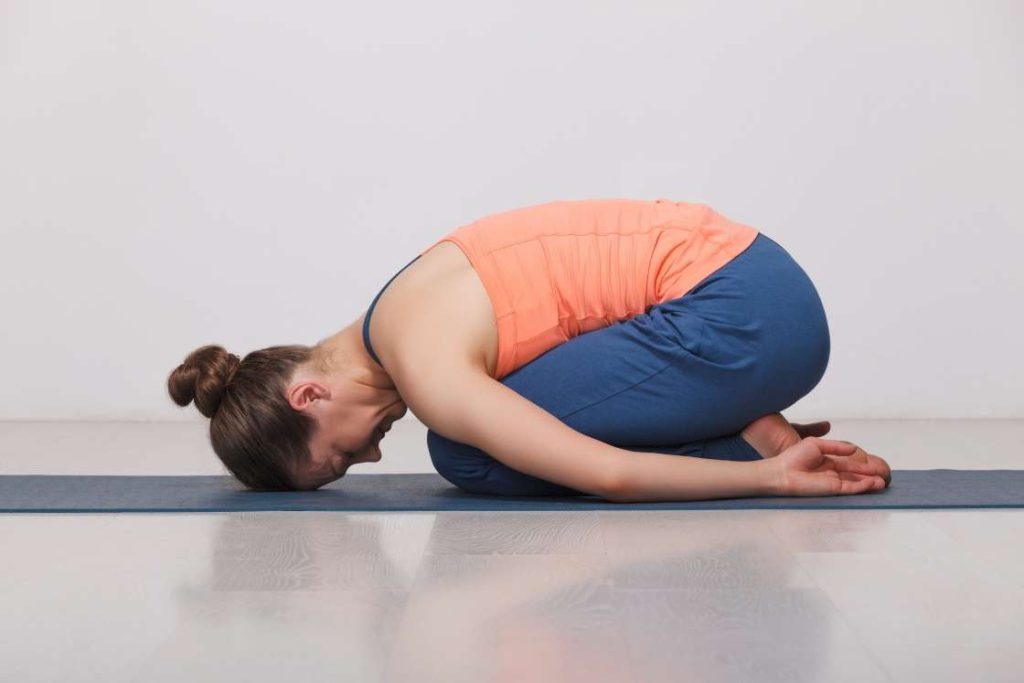
Child’s pose is one of the signature resting poses, for your entire body, including your tailbone. The seating posture of the child’s pose creates sacrococcygeal extension in your tailbone. The forward bend encourages you to add the posterior pelvic tilt to your tailbone. The child’s pose will also extend your hip joint and stretch your lumbar curve.
- Get down on all fours, hands and knees.
- Keep your legs very close to each other.
- Knees below the hip and hands below your shoulders.
- Look down.
- Extend your toes out.
- Push back, let your thighs fold back, and sit with your sitting bones on your heels.
- Your upper body will be bend down and pressed on your thighs.
- Your hands should stay stuck to their very initial position.
- Flex your lumbar region, creating a dome shape with your spine.
- Stretch out your upper back, push down with your chest.
- Keep your head pressed down on the floor.
- Take. Comfortable 10-15 breaths.
Note for tailbone – Once again this pose will naturally flex your tailbone into counter-nutation. But, unlike most poses, in child’s pose you must let the tailbone remain in counter-nutation and not play around with the tilt.
5. Cobra pose
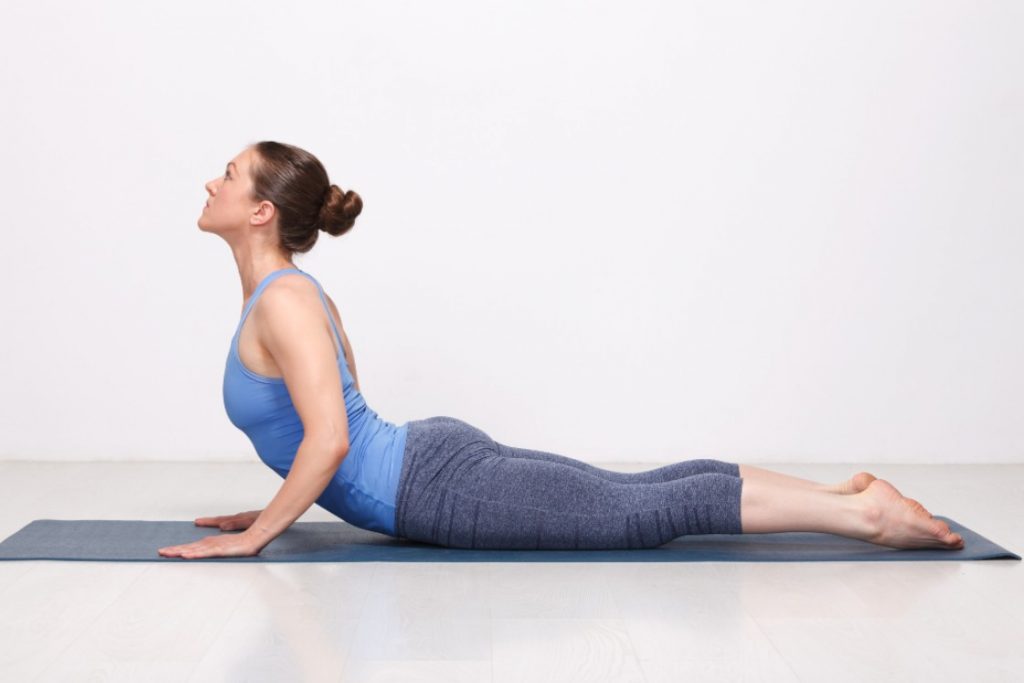
Cobra pose is the most versatile spine-benefiting pose. This pose evenly stretches your entire spine from your tailbone to the base of your head. This pose will flex and compress your tailbone vertebrae. The Cobra pose will also be important in increasing the nervous functions along your spine. The increased nervous functions will play a critical role in consciously exercising your tailbone.
- Lie on the floor on your front.
- Keep your legs hip length apart.
- Bring your hands by the sides of your chest and plant your palms against the ground.
- Push against the ground and arch up your upper body, and spine, from your hip.
- Make sure you keep your hip pressed down to the ground.
- Keep arching up till you can look infront straight.
- Push your chest out and infront.
- Keep your shoulders pressed down
- Keep the arch in your spine even.
Note for tailbone – This pose will pull your tailbone into sacrococcygeal extension. You can increase the stretch in your tailbone and increase the extension, but do not tilt.
Tailbone Pain & Body Awareness
When we randomly stretch and flex to shake off our body aches and pains, the coccyx pain is mostly left unattended. The back arches, spinal twists, and forward bends are all very comforting, but they exercise your entire hip-spine-pelvis region together, as a whole.
In order to relieve your coccyx pain, you need to isolate your tailbone and specifically stretch and flex it. That is precisely what yoga poses do. Yoga will help you consciously feel out your tailbone from the rest of the joints and muscle groups of the region. This conscious feeling will stimulate your CNS to sense the end part of your spine, your tailbone, and activate it for specific movements and stretches.
A major element of yoga is how it increases your body awareness, and consequently, your control over specific muscles and joints. This high sense of body awareness will help you stay conscious of your tailbone at all times. During every movement and activity, you will remain aware of your tailbone and regulate its subtle maneuvers to avoid bruising.
As you regularly practice yoga exercises for your coccyx pain, you will start getting aware of the muscles, tendons, and ligaments attached to this site, and their connection to your sitting bones. Yoga-induced awareness will also aid you in consciously regulate the movement of the sacrococcygeal joint (the end of your tailbone) which mostly flexes and extends.
Correcting Tailbone Posture
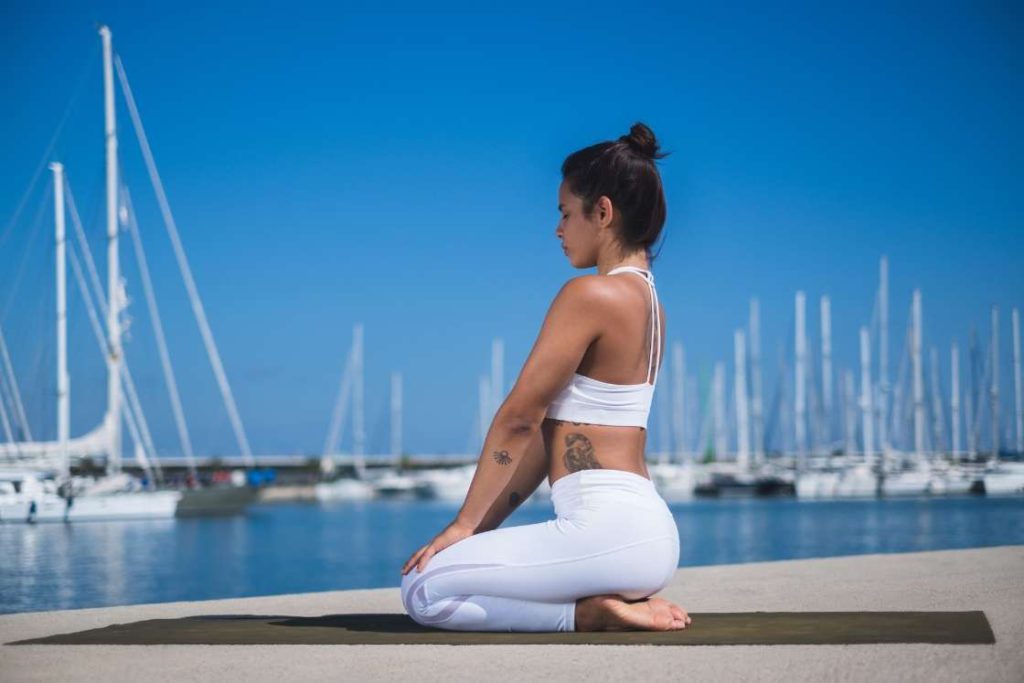
Simple sitting yoga asanas like the easy pose and Vajrasana can be very effective in training your tailbone for appropriate posture. What you need to understand is that your tailbone lies in a complicated region. It is surrounded by other joints and muscles of the hip, pelvis, groin, and sitting bones. These surrounding muscles, ligaments, tendons, and joints need to be strong and flexible enough. Otherwise, they put undesired pull and tension on your coccyx, limiting its subtle maneuvering movements.
Different yoga poses and exercises are well equipped to train the surrounding muscles and joints. Increase their flexibility, strength, and range of motion. The fine blend of static holds and dynamic movements in yoga stretches, like the pigeon pose, for example, prepares the tailbone region to withstand considerate tension without interfering with the posture of your tailbone.
Conclusion
Tailbone pains are generally not a matter of concern. Although, if the region continues to concede repeated injury over an extensive period of time, the tailbone could pick up woeful bruising. In such extreme case surgical intervention will be your only solution.
Thus if you have tailbone pain, do not stop at just remedying your pain. Continue the yoga routine to improve the mobility of your tailbone. With yoga, you will have a long-term solution. Whatever your movements are you will always be aware of your coccyx. And even subconsciously, your spine will continuously make minute maneuvers to your coccyx, to keep it out of harm’s way.
